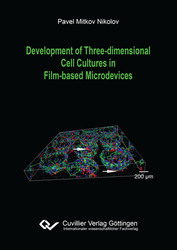| Departments | |
|---|---|
| Book Series (96) |
1378
|
| Nachhaltigkeit |
3
|
| Gesundheitswesen |
1
|
| Humanities |
2364
|
| Natural Sciences |
5406
|
| Mathematics | 229 |
| Informatics | 319 |
| Physics | 980 |
| Chemistry | 1363 |
| Geosciences | 131 |
| Human medicine | 243 |
| Stomatology | 10 |
| Veterinary medicine | 108 |
| Pharmacy | 147 |
| Biology | 835 |
| Biochemistry, molecular biology, gene technology | 121 |
| Biophysics | 25 |
| Domestic and nutritional science | 45 |
| Agricultural science | 1004 |
| Forest science | 201 |
| Horticultural science | 20 |
| Environmental research, ecology and landscape conservation | 148 |
| Engineering |
1792
|
| Common |
98
|
|
Leitlinien Unfallchirurgie
5. Auflage bestellen |
|
Advanced Search
Development of Three-dimensional Cell Cultures in Film-based Microdevices (English shop)
Pavel Nikolov (Author)Preview
Table of Contents, PDF (86 KB)
Extract, PDF (940 KB)
The microthermoforming and respectively the SMART technology (Substrate Modification And Replication via Thermoforming) have proven to be a useful tool, which enables the fabrication of highly defined and reproducible polymer microchips with various depths and shapes. The microthermoforming and its modifications have facilitated development of configurations, which reflect relevant aspects of the in vivo conditions, with respect to morphology and essential biochemical and biophysical cues from the microenvironment or “niche”. The film-based microstructures have unique properties such as small volume and mass, high flexibility, low heat capacity, thermal resistance and high permeability. Notably, the SMART ensures higher flexibility in terms of size and geometry of the polymer substrates, which are crucial for establishment of three-dimensional (3D) cell culturing models. Furthermore, such models might be an initial step towards development of more complex in vitro 3D platforms which can complement the conventional two-dimensional (2D) culturing systems by restating certain components of (stem) cells niches, including spatiotemporal control of dynamic cellular interactions or facilitating the formation of complex patterns in co-cultures, including in vitro tissue-similar models.
The findings in this work provide support for key arguments that the SMART technology can successfully be employed as a major strategy for creating engineered scaffolds which could be assembled into platform for in vitro recapitulating the fundamental physiological properties from natural microenvironments of cells.
| ISBN-13 (Hard Copy) | 9783736990630 |
| ISBN-13 (eBook) | 9783736980631 |
| Final Book Format | A5 |
| Language | English |
| Page Number | 232 |
| Lamination of Cover | glossy |
| Edition | 1. Aufl. |
| Publication Place | Göttingen |
| Place of Dissertation | Karlsruhe |
| Publication Date | 2015-08-12 |
| General Categorization | Dissertation |
| Departments |
Natural Sciences
|
| Keywords | Polymer films, 3D cell cultures, Microfabrication |








